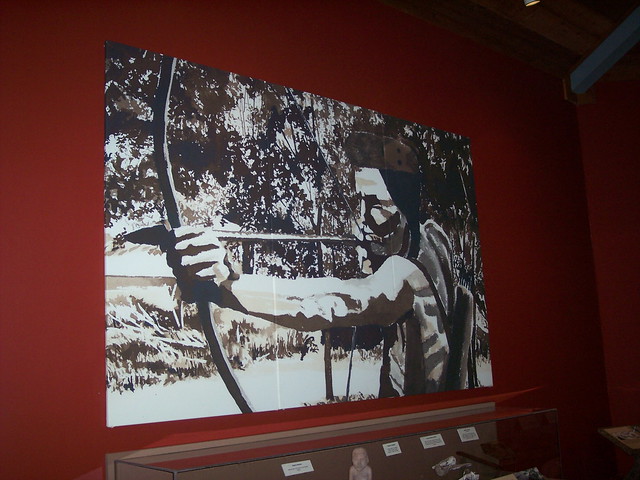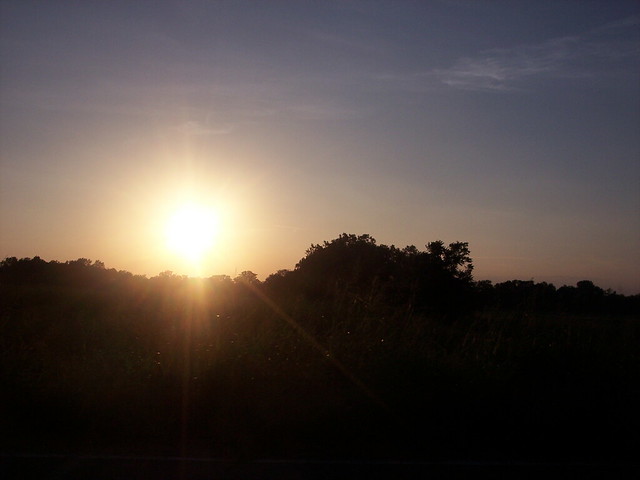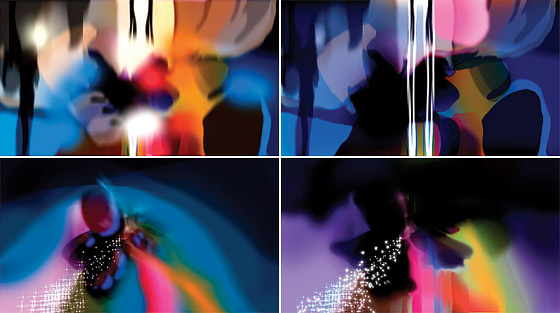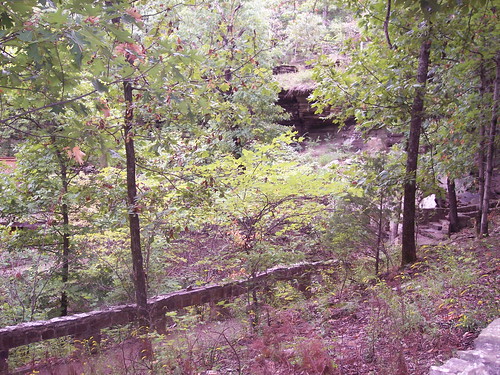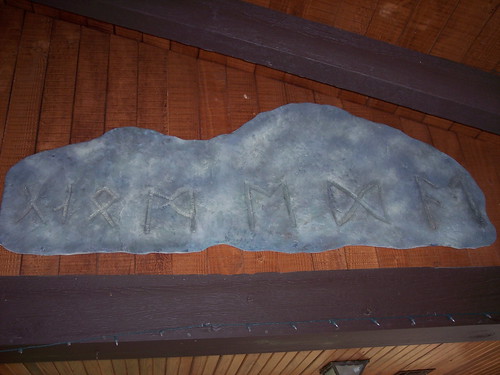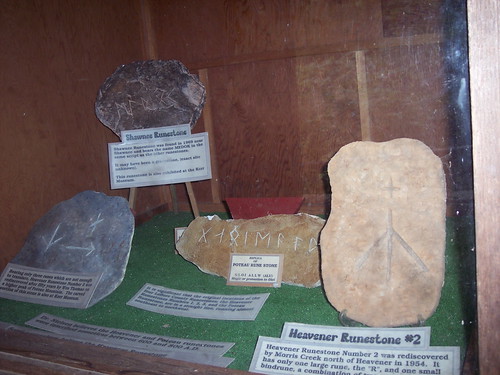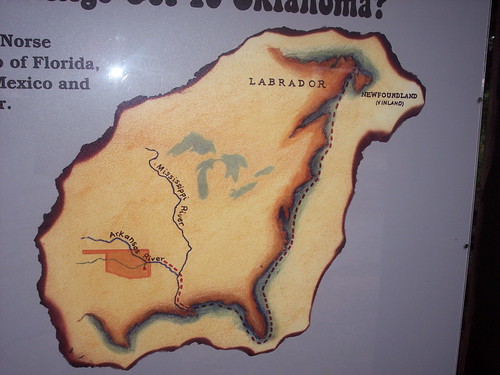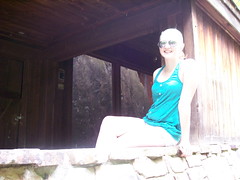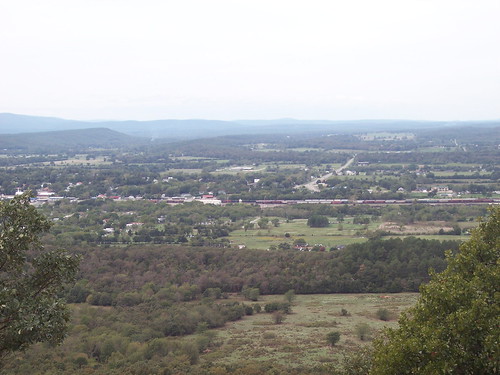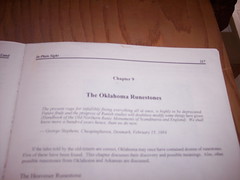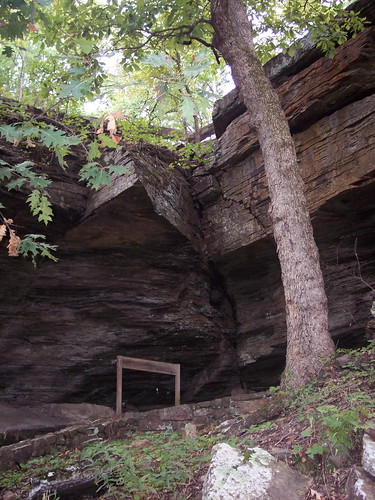The following blog discusses: prehistoric Native American seasonal rituals and cultural artifacts, and the history of the land in the years since then including the highly dramatic trouble created by treasure hunters at the site. Complete gallery of the pictures I took on the trip can be found by >clicking this link<
 [human effigy]
[human effigy]
Spiro Mounds Archaeological Park is located on 140 acres in Spiro Oklahoma near its eastern border with Arkansas. The 12 mound park offers a one-half mile interpretive nature trail year round and a small museum with a gift shop. The park's director is archaeologist Dennis Peterson who leads special tours of the mounds by appointment on Solstices, and during its most impressive astronomical alignment on Fall Equinox. Some of the information in this blog comes from the links & books referenced at the bottom of this entry. Many of the details below come from Peterson's lecture on site at sunset, September 23, 2010 and from my emailed questions that followed. His book recommendations are *starred* in my bibliography below. He did not review this blog pre-posting, so hopefully I haven't screwed up too much of the story in this retelling :)
 [Spiro’s resident archaeologist, Dennis Peterson]
[Spiro’s resident archaeologist, Dennis Peterson]
Spiro is at a bend of the Arkansas River & was the site of a central western political outpost & ritual center for a coalition of around 60 pre-historic Native American tribes. They were known as the Southeastern Ceremonial Complex (SECC) and they dominated the region before colonization. The Spiro site was actively used from 850 - 1450 AD and connected the region with elaborate rituals, an iconographic (picture) writing system, and maintained a huge trade route across the Southern United States stretching from the Gulf of California to the Gulf of Mexico and from the Atlantic coast of Virginia & up to the Great Lakes. Spiro isn't the name of the tribe though. The mound site is named for the nearby city.
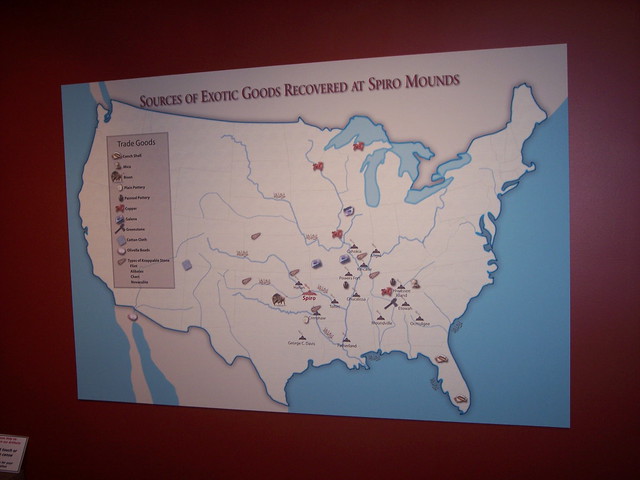
[trade network]
During its heyday, leaders of Spiro orchestrated its people to build over twelve mounds including nine platform mounds and a single burial mound over a period of 400 years. These earthenworks structures were positioned to align with the rising & setting of the sun on certain seasonally significant days acting like a calendar that tracks the seasons.

[mound alignment]
The Temple Mound is the tallest earthenwork structure still intact on the site & is known as the Brown Mound. It steeply slopes on three sides and it is thought that the fourth side had a walkway up to the flat top of this platform mound where a structure was built. Today the top of the mound looks rounded in by erosion like the indent of a cup.
When the moon rose over the mound on Fall Equinox, it sat perfectly embraced by the divot in the top of temple mound. This was beautiful to see when a person stands on the path between the temple & house mounds, astronomical precision at sunset watching the sun align with the house mound & slip down below the peak on the horizon.
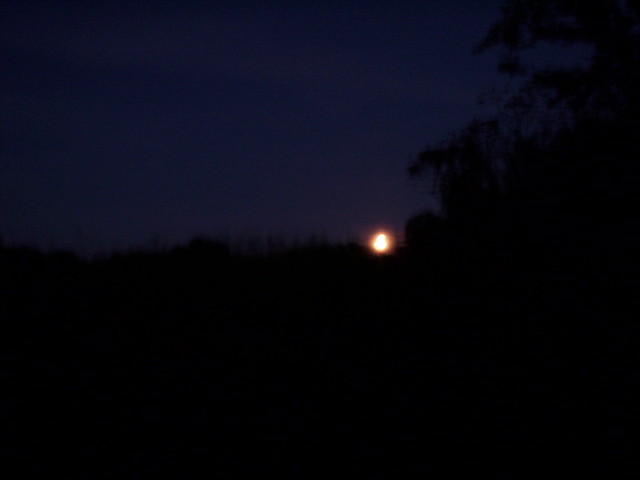 [moonrise over temple mound]
[moonrise over temple mound]
The archaeologist said that Fall Equinox for the tribe was an observance of a harvest ritual. The temple maintained a sacred fire in the ceremonial center. Before the fast, home fires were put out and hearths were cleaned. Women & children were not allowed in the main ceremonial area under penalty of death. Roughly 20,000 men from the region would come together and fast as a community, waiting for the priest to report what the "sundagger" or beams of light had shown them inside the temple mound when the sun shined through slits in the wall. The temple structure had images marked on the walls of its inner chamber that would be illuminated on seasonal holidays. Petroglyph cave paintings with similar iconography to that used in Spiro can be found in Dunbar Cave in Tennessee.
So this passing beam of light was in the right position on certain days to indicate key signs that the priest interpreted and shared related to the community's planting, harvesting, and other planning. Part of the ritual was that the leading gran soleil goes into seclusion for 3 days without food or water and has a vision. During this period the community allows for criminal appeals & judgments to be overturned. This is a time of forgiveness and renewal for the tribe.
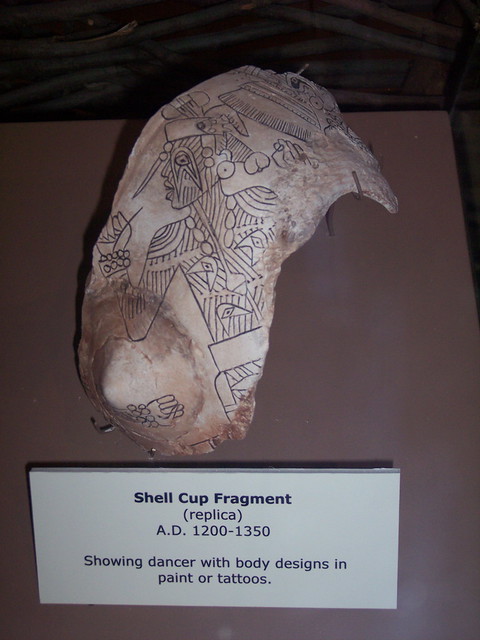
[tattooed Spiro resident with stretched ears]
On the third day the sacred old women are allowed to bring trays of food to the edge of the ceremonial area where the men have secluded themselves under the brush arbors. The priest brings a bowl of sacred fire to house mound #2 and the leader emerges to return with them to the temple mound. The Gran Soleil gathered with other leaders around the sacred fire, which they fed and talked to. Women in the community bring their best pottery to the temple and are given sacred fire to return home with so they may restart the home fires. The whole community then goes to the river to be cleansed and forgiven. After the purification, everyone returns for a potluck dinner to celebrate the fresh start of a new season.
 [dancers]
[dancers]
But that was 500 years or more before everything changed in 1933. It was the thick of the Great Depression and the property was owned by Mr. & Mrs. James Craig who had two young children. Several groups asked for permission to look for treasures in the mounds and were turned away. James Craig died "in the shadow of the mound" with Tuberculosis not long after meeting those who would become known as the "Pocola Mining Co"
So the parents of these children die under mysterious circumstances and the property is inherited by the kid's grandfather George Evans, who becomes their guardian. The old grandfather agreed to give the group a two year mining lease for $50 which led to one of the greatest archeological disasters in North America.
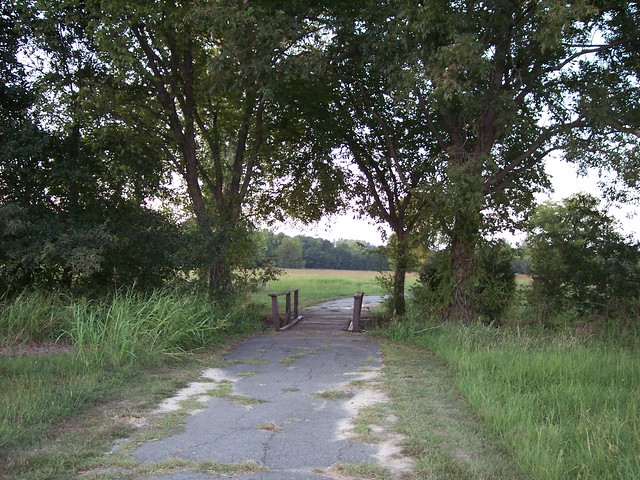 [path to Spiro Interpretive Trail]
[path to Spiro Interpretive Trail]
The group spent the season harvesting the burial mound haphazardly, searching for gold & jewels that did not exist. It was readily apparent that the site contained ancient artifacts that were meant for museums. So the group immediately began peddling artifacts on the open market, labeled "From the Temple Mound in the Fort Coffee Bottoms near Spiro, Oklahoma, USA."
Artifacts from Spiro can currently be found in the collections of the Louvre, British Museum, Smithsonian, Victoria & Albert Museum, Heritage, Houston Museum of Fine Art, Ohio State Museum, Oklahoma History Society and the interesting sounding Wool-a-roc Museum & Nature Preserve in Bartlesville, OK. A large collection belongs to Oklahoma University, but there are many more universities with Spiro artifacts in their collections such as University of Arkansas and Gilcrease in Tulsa. In 1935 the Kansas City Star referred to the site as the "King Tut of the Arkansas Valley" based on the artifacts being sold by the Pocola Mining Company.

Soon, the treasure hunters got impatient enough to hire coal miners to "excavate". It was also reported by the Kansas City Star that a 14' tunnel had been built straight through the mound, large enough for a man to walk through with a wheel barrow. At the end of the lease, the once 33' tall burial mound was honeycombed with smaller tunnels. Interestingly there were no cave ins, although no shoring or timber was replaced by the miners. Around the same time suspiciously found drown in a shallow stream was the company's local contact R.W. Wall who also worked for the land owner’s as the project secretary.
Forrest E. Clements in the Anthropology Dept. of the University of Oklahoma started hearing about a deluge of undocumented artifacts originating from the area and it was the first the scientific community had heard of the looting going on in Spiro. In the beginning, they thought the artifacts were forgeries since the like had never been seen or unearthed. When the reality of the situation set in, Clements unsuccessfully tried to buy out the Pocola Mining Co. Finally, state legislature passed licensing requirements to protect the site. A lawyer who opposed the antiquities bill died unexpectedly just before the vote and local rumor attributed the death to a curse on those who had anything to do with the defiling of the tribe's Burial Mound.
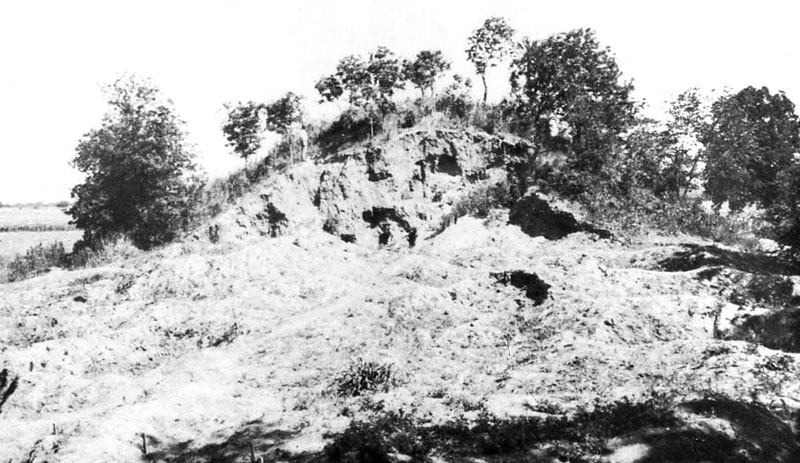
[1936 image of destroyed mound from UT Austin link below]
"The diggers paid no attention to the new law until the deputy sheriff paid them a visit one day in the summer of 1935. After they were informed of their illegal act of digging and after "several threats of mayhem" they gathered up their tools and left....At this point the main cone on Craig Mound was pretty well intact and Clements believed the battle was won. So, not worrying about the site's destruction anymore, he took a summer teaching appointment in California and left. Most of the people who lived in the area were living within a rural community ...and archaeology was not an important issue. No one really cared to enforce the law so when ...Clements wasn't around to check up on things, the diggers moved back in and finished out their lease which ran until the end of summer. " (from Bostrom's blog)
At the end of 1935, the burial mound known as Craig Mound was blown up with a charge of black powder allegedly by the Pocola "Mining" Co. When the teacher Clements returned from his semester out of state, he found the remains of the mound littered with broken shell, pottery and bones. Feather robes were trampled by the plunder and destroyed cloth and baskets lay in bits. It was too late; the explosion had defiled what was left of the burial mound which had been so carefully created by this stone age civilization
 [Engraved Shell Gorget ]
[Engraved Shell Gorget ]
Clements wrote "the great mound had been tunneled through and through, gutted in a frenzy of haste. Sections of cedar poles lay scattered on the ground, fragments of feather and fur textiles littered the whole area. It was impossible to take a single step in hundreds of square yards around the ruined structure without scuffing up broken pieces of pottery, sections of engraved shell, and beads of shell, stone and bone."

In 1936, the University of Oklahoma archaeologists & a team of WPA workers excavated the rest of the Craig Burial Mound completely and salvaged many unearthered remains at the site. The war ended the project in 1941 but the mounds were eventually reconstructed in the 1970's. The reconstruction intended that the mounds would look as they did in photographs taken by local historic society member Joseph Thoburn before 1914 when the mounds appeared to still be undisturbed and intact. The "great mortuary" or Craig burial Mound was estimated to be 33' above ground level and 115' in diameter. The smaller other mounds average 20' high x 80' wide and many are believed to have remained undisturbed and have not ever been excavated. Most of the mounds were "for buildings to be placed upon or to cover old houses."
 [underlying structure of house mound]
[underlying structure of house mound]
Much of OU's artifacts from the excavation in the 1930's are today overseen by Sam Noble at the Oklahoma Museum of Natural History. The school found more than 600 burials and over a thousand artifacts. From the 60's-80's, more excavation was done by the Oklahoma Archaeological Survey that also was of academic quality.
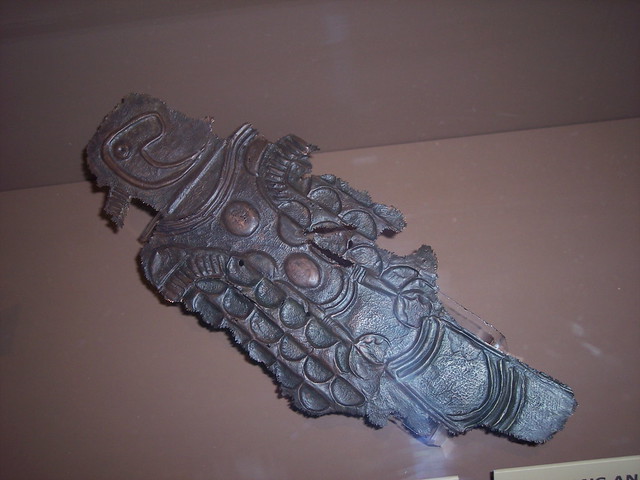 [unearthed representation of mound site in copper]
[unearthed representation of mound site in copper]
Unfortunately, the earlier artifacts were taken from the burial mound by Pocola Mining Co. before the university came to insure proper excavation. Thousands of objects were not properly cataloged and were removed without regard to their placement. As Peterson said, the artifacts are now permanently out of context "like pages ripped from a book." A good example is the carved ax heads found placed in a circle on staged skeletal remains. Many copper axes found in Spiro had handles made of persimmon wood carved into the shape of bird heads with eyes inlaid with shell.
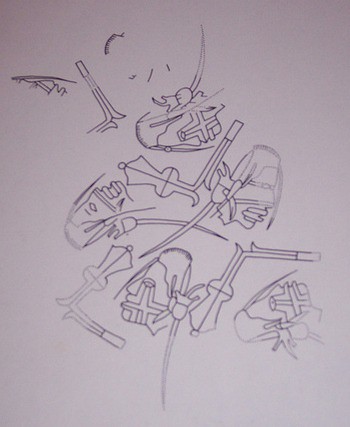
[burial placement in circle of ax handles with beheadings]
Spiro was known for exotic burial ceremonies for elite members of its society. Planting & Harvests were celebrated. It was also the location of Seasonal Ceremonies including the Black Drink Ritual or other purging acts including smoking rituals involving smudging and the swallowing of pipe smoke in large gulps to invoke vomiting to expel or detox before a fast.
The leader, the Gran Soleil, smokes in the temple to purge before the 3 day fast then goes into seclusion in the house mound #2 in order to have his vision for the next season's planning to lead his people. This leader is thought to be an intermediary between the lower & upper worlds, the earth and the sun. He is thought to communicate with the sun and returns to advise the people.

 There are consequently many large effigy pipes for smoking that were unearthed from Spiro. The 'Smoker' is in OU's collection and measures over a foot in length and was made in Illinois and brought to Spiro as part of an exchange between chiefdoms. This artifact is thought to have been originally created at Cahokia near St. Louis and was exported down river to Oklahoma. The ancient civilization in Spiro smoked a weaker everyday tobacco flavored with fruit or mint. Ritual smoking was used as a purge with intensely stronger tobacco that was considered sacred.
There are consequently many large effigy pipes for smoking that were unearthed from Spiro. The 'Smoker' is in OU's collection and measures over a foot in length and was made in Illinois and brought to Spiro as part of an exchange between chiefdoms. This artifact is thought to have been originally created at Cahokia near St. Louis and was exported down river to Oklahoma. The ancient civilization in Spiro smoked a weaker everyday tobacco flavored with fruit or mint. Ritual smoking was used as a purge with intensely stronger tobacco that was considered sacred.
[The Smoker Effigy Pipe at OU]
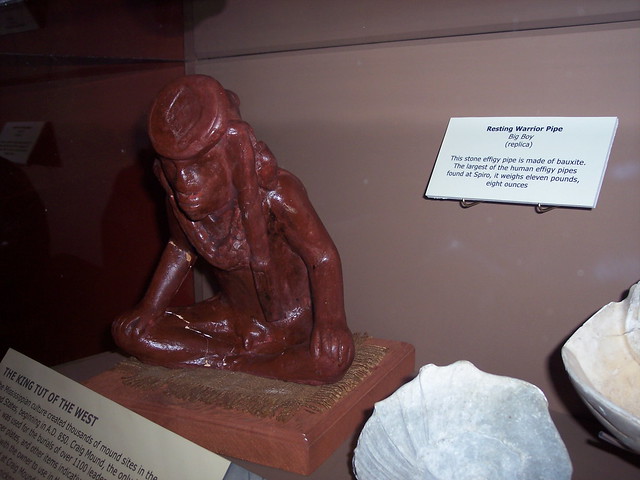 [Big Boy Effigy Pipe representing mythic hero Red Horn]
[Big Boy Effigy Pipe representing mythic hero Red Horn]
The far area near the burial mound was once a habitation area in the early days that the site was used. On an elevated area to the west of the burial mound is a ceremonial complex of 8 mounds surrounding a plaza. The people of Spiro engraved copper; made beads from stones, shells & seed pearls; farmed the land, hunted for food, decorated their bodies with tattoos, had stretched ears & wore spacers made of copper or stone (some of these ear spools measured 3” in diameter). The bows made in Spiro from Bois d'Arc wood were highly prized trade items across the region. Also popular for export were the lightweight gardening tools made from bison scapula favored by women & children who sowed the fields. Other crafted artifacts have been found such as the pipes and human effigies made of cedar or stone. Tools have been unearthed like stone maces and carefully created ax handles.
 [EAR SPOOLS Comparison from UT Austin site]
[EAR SPOOLS Comparison from UT Austin site]
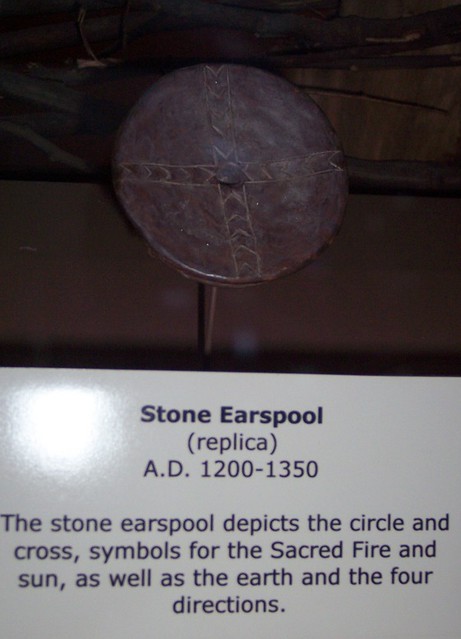 [SPACERS aka EAR SPOOLS]
[SPACERS aka EAR SPOOLS]
The big shot leader was known as "Gran Soleil" and when they died their prized possessions were buried with them in the mound. Their servants & wives considered it an honor to be ritually beheaded & buried with the leader when it was his time to go. As many as 20,000 people from far outposts of the tribe came to Spiro with baskets of dirt to contribute to the mound burial ceremony. When the bodies were prepared and placed on top of the burial mound, a teepee like structure was made over the offerings with upright cedar poles leaning inward placed in an "irregular circular pattern. The sides of this structure were then packed with dirt...and rapidly covered. As a result...a hollow chamber was left behind, roughly 15-20' in diameter and 8-10' high" Excavation found lime coating the inside of the structure had built up over time which sealed and helped preserve many of objects that now act as a record of this lost culture. Upper layers of the mound contain lesser ranking burials and later deposits offered "a total lack of grave goods" in the later period (from spiromounds.com)
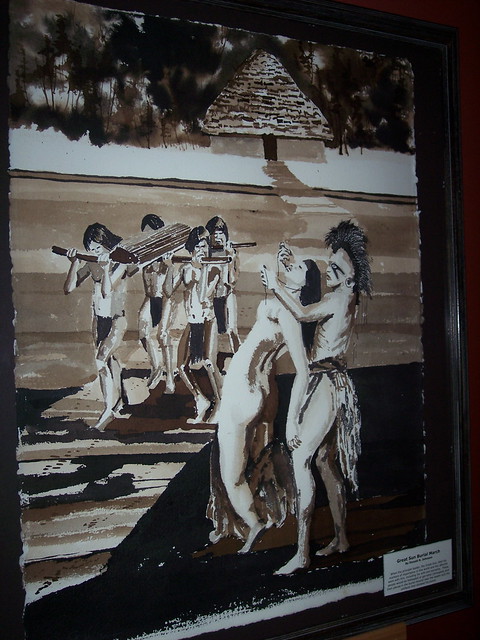 [ritual beheading of servants who have the 'privilege' to be buried with their leader in the mound]
[ritual beheading of servants who have the 'privilege' to be buried with their leader in the mound]
It is thought that the Spiro people were ancestors of the Caddo, Wichita & Kichai tribes. The burial rites of Spiro were continued by the Natchez & Choctaw tribes. Spiro cosmology was kept by many including the Cherokee & Muscogee tribes. Spiro descendants could possibly be the Tula tribe found by DeSoto upstream on the Arkansas River in 1542. By the late 1800’s when the original owner of the land named Rachel Brown claimed to have seen "ghosts & blue flames" around the Indian mounds the tribe who created them was a mystery.
We don't have a name for the Mississippian period tribe at Spiro although they are considered to be part of the Southeastern Ceremonial Complex, sometimes referred to as the Southern or Buzzard Cult. Birds are a recurring image and theme with the tribe and many of its rituals.
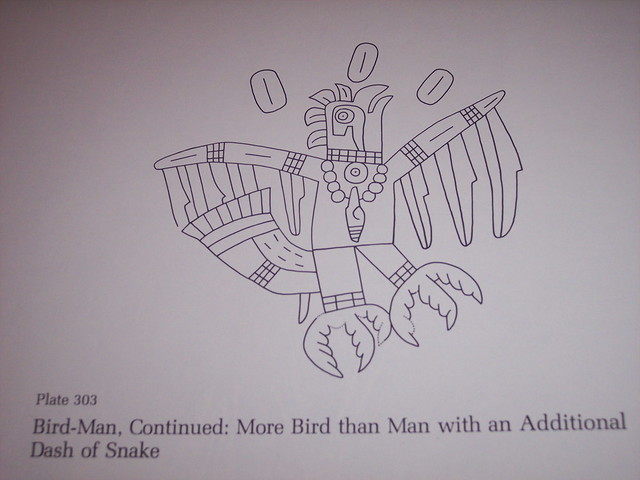 [birdman]
[birdman]
Hawk Dance or Eagle Dance is common to many regional tribes especially in the Mississippi area. "Raptors were considered messengers between this world & the upper world" said Peterson. One of the artifacts in the Spiro Museum is a conch shell imported from South Florida, brought to Spiro to be engraved with an iconic image of a Raptor. Many of these
 engraved shells were sent with couriers who were asked to memorize stories correlating with the images. The stories were retold to priests and leaders in far away cities by the Spiro messenger helping to unite the network of tribes with similar archetypes and ideas about cosmology and stories of how they believed the world worked. The images were recreated on pottery made in the outposts that received the engraved message from Spiro, helping perpetuate the unified stories spread to the common people sent everywhere they traveled & lived.
engraved shells were sent with couriers who were asked to memorize stories correlating with the images. The stories were retold to priests and leaders in far away cities by the Spiro messenger helping to unite the network of tribes with similar archetypes and ideas about cosmology and stories of how they believed the world worked. The images were recreated on pottery made in the outposts that received the engraved message from Spiro, helping perpetuate the unified stories spread to the common people sent everywhere they traveled & lived.
[RAPTOR engraving done in Spiro on conch shell imported from Florida]
Dennis Peterson's lecture talked about the migration of people to this continent, about burial rites of the tribe and how leaders were chosen. I especially found Peterson's ideas about the end of the culture fascinating.
Theories suggest that global climate changes in the 1300's contributed to the demise of the culture. Europe experienced a little Ice Age and the North American South had 100 years of drought. Weather changes increased bug populations and threw off predator/prey ratios. A darker mood developed when new creatures moved into the area like the predatorial jaguar with its unnerving scream like a woman in pain. Overpopulations by in the the screeching pileated woodpeckers didn't add pleasant sounds to the forest either.
The drought also encouraged the immigration of the unusual looking armadillo into the area, but the prehistoric people thought the armadillo brought the drought instead of the other way around. The elaborate rituals thought to improve their chances did nothing to feed the poor who began to rebel against the obligations given to them by their wealthy leaders.
 [ceremonial cup used in black drink ritual, made of shell engraved with armadillo images]
[ceremonial cup used in black drink ritual, made of shell engraved with armadillo images]
The Lecture speculated that much like today, 700 years ago leaders tried to (1) deny the problem existed for at least one generation which worked for less than 20 years, then tried (2) blaming others [like suggesting new animals species were causing starvation], next leaders defensively supported a (3) shift from regional sharing of power to an attempt at centralized power, finally causing (4) adaptation or overthrow of the political system in power.
In response to their disillusionment with politicians and priests that could not control global climate change, the people eventually quit paying taxes or participating in ceremonies. Respect for authority was gone and mound building ends. Shift of power is taken from leaders, and trappings of power are given up. Regional trade shrivels and only insular local trades continue. With the lack of respect for leaders or their ambassadors and no trade diplomacy, violence between the tribes escalates and the civilization at Spiro fractures, factions and ends.
 ~ DIRECTIONS to Spiro Mounds Archaeological Park:
~ DIRECTIONS to Spiro Mounds Archaeological Park:
Spiro Mounds Park is 3 miles east of Spiro off Hwy 271, then 4 miles north on Spiro Mounds Rd. The city of Spiro is just a few miles away from a Dam on the Arkansas River (near Lake Wister State Park). Park is open May through October. Reservations for tours is recommended by calling Dennis Peterson at 918-962-2062 or emailing spiromds@ipa.net or contact@spiromound.com - 18154 First Street, Spiro 74959
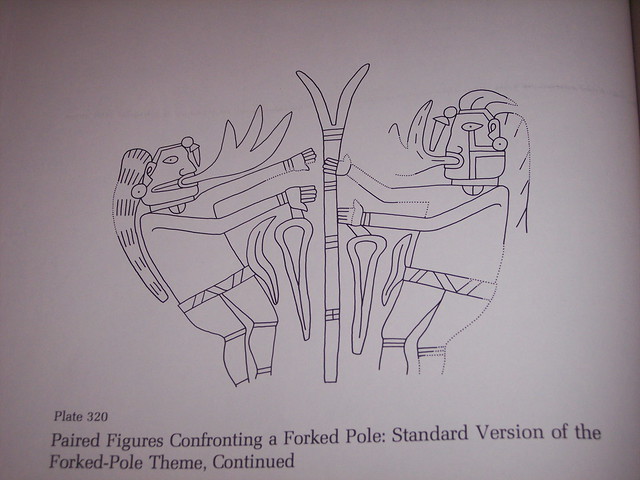 [engraving with axis mundi staff]
[engraving with axis mundi staff]
~ BIBLIOGRAPHY:
-- more info on seasonal rituals of the Spiro tribe read:
*(-) the very readable 573 pages "The Southeastern Indians" by Charles Hudson published by University of Tennessee Press, TN (1976).
(-) "Ancient Objects and Sacred Realms: Interpretations of Mississippian Iconography (Linda Schele Series in Maya and Pre-Columbian Studies) [Paperback]" edited by F. Kent III and James F. Garber. published by University of Texas Press, Austin, TX (2009).
* (-) "Black Drink." by Hudson, Charles M. (1979). University of Georgia Press. pp. 83–112.
-- more on tribal cosmology & their origin stories for fire or creation read either:
*(-) "Native American Legends: Southeastern Legends Tales from the Natchez...and other Nations (American Folklore Series) by George E. Lankford published in hardcover by August House Press (1987).
or the author's new book to be released in January 2011:
(-) "Visualizing the Sacred: Cosmic Visions, Regionalism, and the Art of the Mississippian World (Linda Schele Series in Maya and Pre-Columbian Studies)" Edited by George E. Lankford published again by August House Press (2011).
-- other Spiro related information found in:
(-) The Spiro Ceremonial Center: the Archaeology of Arkansas Valley Caddoan culture in Eastern Oklahoma by James A. Brown (University of Michigan, Memoirs of the Museum of Anthropology, Number 29, 1996).
(-) "The Spiro Mound." by Henry W. Hamilton The Missouri Archaeologist, Vol. 14 October.
(-) "The Oxford Companion to Archaeology" by Brian M. Fagan, pg. 686
~ tribal design images taken from following limited pressing six volume large formant museum book which catalogs over 1,400 designs:
"Pre Columbian Shell Engravings: from the Craig Mound at Spiro, Oklahoma" in six volumes by Philip Phillips and James A. Brown with collaborators. Published in Large Format as a Limited Edition set by Peabody Museum Press. Peabody Museum of Archaeology and Ethnology, Harvard University, Cambridge Massachusetts. (1975-1983)
from aLibris.com: "Unequaled in North America as a single source of prehistoric figurative and decorative art, the Craig burial mound was plundered by commercial diggers in 1933. Hundreds of fragile shell artifacts covered with engraved designs were quickly sold and, whole or fragmented, were scattered in public and private collections across the country. For the past ten years, Dr. Philip Phillips, Honorary Curator of Southeastern Archaeology at Harvard, has supervised a massive project that has involved making rubbings and line drawings of this whole corpus of Southeastern Indian art, matching hundreds of fragments, and classifying the engraved designs by schools. Volume VI, the last volume of the set, deals with the final phase of the Craig style, then concludes with a summary of the study, a bibliography, and an extensive index."
 [engraving of Janus headed rattlesnake crowned with Antlers]
[engraving of Janus headed rattlesnake crowned with Antlers]
~ LINKS for the BLOG:
www.spiromound.com/pages/history.htm (park site)
http://digital.library.okstate.edu/encyclopedia/entries/s/sp012.html (by Dennis Peterson for Oklahoma Historical Society)
http://www.texasbeyondhistory.net/tejas/fundamentals/spiro.html (excellent UT Austin site)
www.ou.edu/cas/archsur/counties/leflore.htm (OU site)
www.exploresouthernhistory.com/SpiroMounds1.html
www.okhistory.org/outreach/museums/spiromounds.html (Oklahoma Historical Society Site)
http://en.wikipedia.org/wiki/Southeastern_Ceremonial_Complex (includes Red Horn hero myth)
http://www.lithiccastinglab.com/gallery-pages/spirocraigmoundpage1.htm (excellent blog called "History of the Destruction of Craig Mound" by Pete Bostrom)
~ epilogue
- There are four remaining places to see evidence of settlements from this tribal network called the Southeastern Ceremonial Complex, one of which is Spiro. Further exploration can be found at Moundsville Park & Museum in Alabama (moundville.ua.edu), in Georgia at Etowah Mounds Day-use State Park (www.gastateparks.org/EtowahMounds) and the fourth site was considered to have been the main capital of the prehistoric SECC tribes & can be explored in Illinois at Cahokia Mounds State Park & Museum(cahokiamounds.org). Cahokia was thought to have a population at its peak of 50,000, when Spiro had around 10,000 back then.
- No connection has been established between the mound building tribes of SECC and those built by the Mesoamerican Toltecs and Aztecs in Mexico. Maps that mention Toltec modular distances between mounds refers to standards established in Scott, Arkansas at the Toltec Mounds site, misnamed long before researchers had decided there wasn't enough evidence to tie together the mound builders of both areas.
- Equinox (n.) "the time when the Sun reaches the point along the elliptic where it crosses into the southern celestial hemisphere marking the start of autumn in the Northern Hemisphere" from the astronomical site http://skymaps.com which offers free monthly star charts for stargazers to print & use to identify constellations and other sights if you have access to a sky full of stars or a telescope.
